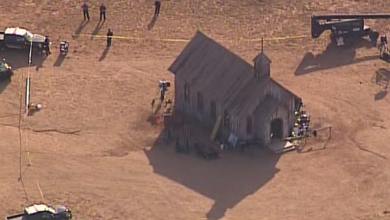
On the first day of Black History Month 2021, a group of Wisconsin teachers gave sixth grade students an assignment asking them how they would “punish” a slave.
As the month drew to a close, a Florida high school teacher was suspended with pay after allegedly telling students slaves were not whipped by white people and that the N-word, a racist slur, “just means ignorant."
Last February, a student-teacher in Tennessee gave her fourth grade students an assignment called "Let's Make a Slave" on a speech about keeping Black slaves under control.
In 2019, a fifth-grade teacher was accused of holding a mock slave auction in which white students bid on Black students in New York.
Careless assignments and lessons like these can traumatize students and experts say they are just one example of how teachers in the United States have long struggled and failed to teach the complex history of slavery.
"Unfortunately (slavery is] addressed often in ways that are either marginalizing or it's the only way that Black people ... are brought into the curriculum," Keffrelyn D. Brown, a professor of cultural studies in education at the University of Texas at Austin, said.
Black History Month 2021:Why is Black History Month in February?
'He did not want to be Black anymore'
In May 2019, former teacher Patricia Bailey made Nicole Dayes' son and another Black student stand in front of their class while other students bid on them during a social studies lesson at North Elementary School, according to a lawsuit filed on Dayes' behalf.
The children were told to refer to the winning students as masters and were warned not to try to escape because they would "be chased down and violence would be done to them," according to a report from the New York Attorney General's office.
Dayes said her son, who is now 12, had to receive counseling after the incident, which the attorney general's office found had a "profoundly negative effect on all students present – especially the African American students."
"He told me that he did not want to be Black anymore," Dayes said. "He didn’t want to go to school because he didn’t know if he could trust the teachers."
More than a year and a half after the incident, Dayes said her son still worries that he's being judged because he's Black when they're out in public and his friendships in the small town have been seriously affected.
Emotional toll hits Black families:African Americans face harmful mental health effects every time incidents of police brutality go viral
'Not isolated incidents'
Simulations are a useful way to teach some parts of history, like civic education, but using this technique to teach about slavery is ineffective and fails to consider the impact on students, particularly Black students.
These kinds of lessons are just one symptom of the systemic problems with how American schools teach – or in some cases fail to teach – about slavery and Black history as a whole.
Brown said when teachers ask students to imagine themselves as slaves or slaveowners, they may be simply attempting to bring history to life to build empathy or give students a more emotional and visceral experience.
"We can never recreate nor should we want to recreate enslavement," she said. "It minimizes the trauma of the history itself."
There are currently no groups tracking how often incidents like this happen across the country, but Brown said it's clear these kinds of lessons are being taught at multiple different grade levels in many locations across the country.
"These are not isolated incidents," she said.
Florida teacher denies slaves' abuse:Teacher in viral TikTok videos suspended with pay, district investigating
Dozens of teachers "proudly" reported that simulations were their favorite lessons when teaching about slavery, according to a 2018 report titled "Teaching Hard History" from the Southern Poverty Law Center, which surveyed more than 1,700 social studies teachers and analyzed textbooks.
Multiple teachers said they had students simulate the Middle Passage, the sea journey taken by slave ships from West Africa, others had students clean cotton and role-play as enslaved people and enslavers.
In addition to the problems with simulations, the SPLC report found that the U.S. education system fails to effectively teach about slavery across the board.
Teachers fail to discuss the relationship between white supremacy and slavery, teach about slavery as an exclusively southern system, focus on the white experience instead of the perspective of enslaved people, and rarely make connections between slavery and present day structural racism, according to the report.
Machayla Randall, a senior at Cherry Hill East High School in New Jersey, said she grew disappointed and uncomfortable after years of only learning about the civil rights movement and slavery in school. She said she was never upset with her teachers, but always wanted more from the curriculum.
"The fact that we only discuss (slavery) is kind of dehumanizing for the African American culture," she said. "Especially in the perspective of history textbooks we’re only seen as tools and people that were utilized."
Brown said teachers continue to struggle with lessons around slavery because they are not properly trained and because the country itself has had a difficult time addressing race and racism. Although some states adhere to common core standards, there is no national standard for teaching slavery, she said.
'A very scary' suggestion:Republican state lawmakers want to punish schools that teach the 1619 Project
Slavery simulations should never be used in the classroom, according to Jalaya Liles Dunn, director of the SPLC project that produced the Teaching Hard Histories report. Instead, primary source documents can offer students more insight into true experience of slavery, she said.
Teachers are also encouraged to explain the root causes of the institution of slavery, the connection to political power and how those injustices still impact life today.
"We need to be honest and tell the truth," she said. "We can’t romanticize it."
Brown, the University of Texas professor, is cautiously optimistic that more conversations are being had about this topic, but also said she has experienced pushback to talking about racism.
"I’m curious to see how that will play out and whether we will see it to its full fruition or if we will let this moment pass as moments have passed before without really doing the work," she said.
What can parents do if this happens to their child?
If parents encounter a problematic assignment Brown said the first step is to talk to the teacher to better understand the intention of the lesson and what the rest of the curriculum entails.
"That's where you can begin to push for a more expansive and really transformative curriculum experience at the school," she said.
As a parent of two school-aged children, Brown also said it is important for kids to learn about hard histories including slavery at home first and to humanize the experience of people who were enslaved. She again emphasized that parents should make sure slavery is not the only time their children learn about Black history in school.
"As an African American parent or parent of Black children I am interested to know how do Black people and the Black experience play out in the curriculum," she said.
How to talk to kids about racism:George Floyd. Ahmaud Arbery. Breonna Taylor. What do we tell our children?
LaGarrett J. King, an associate professor of social studies education at the University of Missouri who also contributed to the Teaching Hard History report, also suggested parents look at the assignments their children are being given and consider what kind of message or narrative the work presents. He said parents should better educate themselves about the history of slavery and use additional resources to supplement what students may or may not learn in the classroom.
He noted that even when students are taught about slavery in a complex way, it can be difficult for them because "history is psychologically violent." Creating space for students to critically examine the actions of people who have not be historically held accountable is "extremely important."
"Holding white people historically accountable for their actions is extremely important if we’re going to teach slavery in a more humane way and complex way," he said.
Students are pushing for change
Black students across the country are demanding better Black history lessons in their schools.
Only a few states including New Jersey, Florida and Illinois require public schools to teach Black history but what exactly is taught is often decided by school districts.
Randall, the New Jersey senior, and members of her school's African American Culture Club worked with authors and college professors to develop a Black history course which was approved by the school board. The Cherry Hill School District became the first in New Jersey to require students to take African American history in order to graduate Tuesday.
Inspired by a trip to the National Museum of African American History and Culture in Washington, D.C., students at Dr. Martin Luther King Jr. Early College got the Denver Public Schools Board to unanimously vote to pass their resolution which ensures the narratives and knowledge of Black, indigenous, Latino and other communities of color are incorporated into every part of the district’s curriculum.
Kaliah Yizar, Dahni Austin, Alana Mitchell, and Jenelle Nangah are now pushing to make that resolution a reality by including a new textbook, Black History 365 into the curriculum. Yizar, a sophomore, said only focusing on select civil rights leaders and slavery minimizes the entirety of Black history.
"When you only teach Black kids about them going through trauma and struggling they’re going to think they're only going to be able to have trauma and struggle," she said.
Students at Stanford University launched a campaign called Diversify Our Narrative to get one book by and about a person of color added to the curriculum in every school across the country. The campaign has attracted more than 5,000 student organizers in 850 school districts across the country.
Victoria Gorum, the campaign's director of project management and research, and fellow Stanford sophomore Beth Engeda said they were inspired to join the campaign amid the resurgence of the Black Lives Matter movement last summer. Engeda, the campaign's director of finance, said she saw information about Black history being circulated on social media during the protests and recalled yearning to read books that reflected her own experience in the classroom.
"In school the only time I would get to read about Black people was in history textbooks...they wouldn't really talk about anything other than slavery," she said. "I just thought it would be better if schools had these things already incorporated into their curriculum."
Follow N'dea Yancey-Bragg on Twitter: @NdeaYanceyBragg










